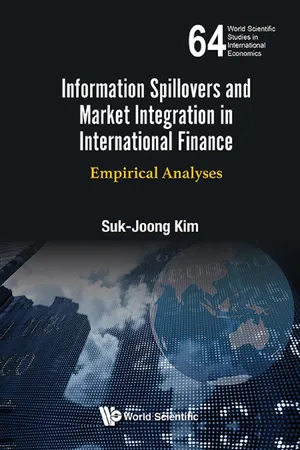
Information Spillovers and Market Integration in International Finance
Empirical Analyses
- 624 pages
- English
- ePUB (mobile friendly)
- Available on iOS & Android
Information Spillovers and Market Integration in International Finance
Empirical Analyses
About This Book
-->
This book volume brings together carefully selected scholarly works covering four inter-related topic areas in international finance. The first section deals with the efficacy and determinants of central bank currency interventions by the Bank of Japan and the Reserve Bank of Australia, the two of the most active central banks in the currency markets in the 1990s and the 2000s. This is followed by chapters that investigate the nature of information processing following domestic and foreign macroeconomic announcements. The third section provides the investigations into the evolving nature of financial market integration and information leadership of major financial centers. The final section presents the studies on the role sovereign credit ratings play in attracting international capital investments.
The comprehensive empirical evidence provided in this book helps readers understand how international financial markets have evolved in their linkages and how information processing occurs in relation to sovereign rating events and other information arrivals.
--> Contents:
- Central Bank Intervention in Foreign Exchange Markets:
- The Determinants of Foreign Exchange Intervention by Central Banks: Evidence from Australia (Suk-Joong Kim and Jeffrey Sheen)
- Intraday Timing of AUD Intervention by the Reserve Bank of Australia: Evidence from Microstructural Analyses (Peter Andersen and Suk-Joong Kim)
- Interventions in the Yen-Dollar Spot Market: A Story of Price, Volatility and Volume (Suk-Joong Kim and Jeffrey Sheen)
- Secrecy of Bank of Japan's Yen intervention: Evidence of Efficacy from Intra-daily Data (Suk-Joong Kim and Anh Tu Le)
- The Role of Macroeconomic News in the Financial Markets:
- Macroeconomic News Announcements and the Role of Expectations: Evidence for US Bond, Stock and Foreign Exchange Markets (Suk-Joong Kim, Michael D McKenzie and Robert W Faff)
- The Spillover Effects of US and Japanese Public Information News in Advanced Asia-Pacific Stock Markets (Suk-Joong Kim)
- Minute-by-Minute Dynamics of the Australian Bond Futures Market in Response to New Macroeconomic Information (Suk-Joong Kim and Jeffrey Sheen)
- The Efficiency of the Information Processing in the Australian Dollar Market: Price Discovery Following Scheduled and Unscheduled News (Lawrence Daniel, Suk-Joong Kim and Michael D McKenzie)
- International Financial Market Linkages and Integration:
- Information Leadership in the Advanced Asia-Pacific Stock Markets: Return, Volatility and Volume Information Spillovers from the US and Japan (Suk-Joong Kim)
- Dynamic Stock Market Integration Driven by the European Monetary Union: An Empirical Analysis (Suk-Joong Kim, Fari Moshirian and Eliza Wu)
- Dynamics of Bond Market Integration between Established and New European Union Countries (Suk-Joong Kim, Brian M Lucey and Eliza Wu)
- Evolution of International Stock and Bond Market Integration: Influence of the European Monetary Union (Suk-Joong Kim, Fari Moshirian and Eliza Wu)
- Sovereign Credit Rating and International Capital Flows:
- Sovereign Credit Ratings, Capital Flows and Financial Sector Development in Emerging Markets (Suk-Joong Kim and Eliza Wu)
- International Bank Flows to Emerging Markets: Influence of Sovereign Credit Ratings and Their Regional Spillover Effects (Suk-Joong Kim and Eliza Wu)
- Do Sovereign Credit Ratings Influence Regional Stock and Bond Market Interdependencies in Emerging Countries? (Rachel Christopher, Suk-Joong Kim and Eliza Wu)
- The Effects of Ratings-Contingent Regulation on International Bank Lending Behavior: Evidence from the Basel 2 Accord (Iftekhar Hasan, Suk-Joong Kim and Eliza Wu)
-->
--> Readership: Graduate students and researchers in international finance, central bankers and capital market participants. -->
Keywords:Currency Intervention;Macroeconomic News;International Capital Flows;Sovereign Credit RatingReview: Key Features:
- Provides important empirical evidence on a number of crucial aspects of International Financial markets
- Easily accessible by advanced undergraduate and post graduate students in International Finance
- Uses non-propriety data that can be used for replication training for research students
Frequently asked questions
Information
Table of contents
- Cover
- Halftitle
- Series Editor
- Title
- Copyright
- Dedication
- Author’s Biography
- Contents
- Introduction
- Part A Central Bank Intervention in Foreign Exchange Markets
- Part B The Role of Macroeconomic News in the Financial Markets
- Part C International Financial Market Linkages and Integration
- Part D Sovereign Credit Rating and International Capital Flows